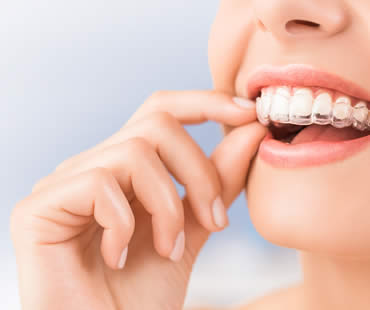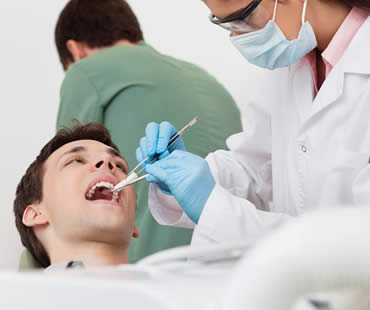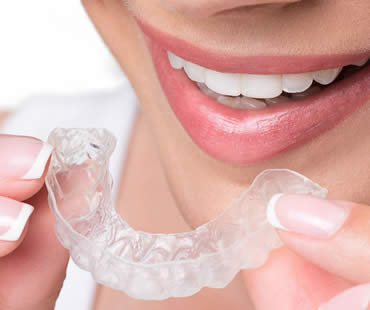
Traditional braces have long been thought to be the only option available to straighten your teeth and correct your bite issues. Advances in Invisalign aligners now give you a choice, one that might just leave your mouth healthier when all is said and done.
Invisalign aligners are clear plastic trays that are worn for up to twenty-two hours a day. They can be removed while eating and for cleaning. A series of trays is prepared to slowly guide the teeth into proper position over time. When one tray has done its job, the next tray in the series is utilized.
Traditional metal braces are extremely challenging to clean. The brackets and bands trap bacteria and food debris all around the teeth, and in order to prevent gum disease and cavities, wearers must thread floss painstakingly under each wire and floss each tooth one-by-one, threading again and again. Brushing is challenging, too, as brushes wear out very quickly and can’t always reach the difficult areas. Even using a waterpick can’t be fool proof, because if used incorrectly, bacteria and debris are simply pushed further into the gum pocket, causing irritation and leading to infections.
Invisalign allows you to take out your trays so you can brush and floss normally, just as you did before you began your treatment. Trays are rinsed with water and placed back in the mouth. The teeth are clean and the aligner is clean, all in a fraction of the time it would take to clean a mouthful of traditional braces.
Keep your mouth healthier by talking to your orthodontist today to see if Invisalign aligners are right for you and your smile goals.
If you live in the Ottawa area contact us today

If you or a loved one is scheduled to have or has recently had oral surgery, you probably have a lot of questions. Here are some of the most common questions:
- One of my stitches came out after my surgery, should I be worried? Losing a stitch isn’t a problem. In the majority of cases, stitches are put in place during surgery to assist in clot formation and bleeding control. If you have undergone a bone-graft procedure, however, contact your surgeon because you may need to be seen immediately.
- What can I eat after surgery? Immediately following surgery, eat only soft foods of tepid temperature. Avoid very hot or very cold foods. Eat nothing that is crunchy or chewy so you won’t damage the surgical site.
- I am having a lot of pain following my procedure, what should I do? If you have been prescribed pain medication, take it as recommended. If no prescription was given, use over-the-counter medicines containing natural anti-inflammatory properties such as ibuprofen. Stay hydrated by drinking room temperature water and get plenty of rest.
- I had a tooth extracted, how can I tell if I have a dry socket? Dry socket is the result of the loss of the blood clot present in the extraction site. Smoking, using a straw, poor oral hygiene or failure to rest properly following the extraction procedure can lead to this condition. Typically dry socket will present within one week of extraction and is treated with sterile wash and pain-relieving, medicated gauze.
- I had a procedure this morning and am still bleeding. Is that normal? Bleeding following extractions or other surgical procedures is common. If you are bleeding more than normal, bite down on some sterile gauze or a damp teabag for twenty or thirty minutes. Don’t keep removing the gauze to look for blood; that can make the bleeding worse. Call your surgeon if you feel your bleeding is excessive.
Your oral surgeon can answer these questions and more. Don’t hesitate to call the surgeon’s office to get the peace of mind you require to heal comfortably following your procedure.
Schedule your appointment at our Ottawa dental office

One of the most popular treatments in cosmetic dentistry is veneers. These thin shells made of porcelain or composite resin are bonded to the fronts of your teeth to hide the flaws of your real teeth. They look natural, resist stains, and are a durable way to restore smiles. Veneers offer a solution for patients with a variety of dental problems.
Fractured teeth:
Teeth that are broken or chipped can be hidden behind veneers, fully restoring your smile.
Discolored teeth:
Stained or yellowed teeth may result from a number of things. Some discoloration such as from foods or age can be improved with teeth whitening treatments. However, stains resulting from things like drugs, large resin fillings, or too much fluoride may not respond to whitening methods. Veneers provide the ability to choose the shade of white you like and get your bright smile back.
Small teeth:
Sometimes teeth are just too small for a person’s facial features. It is difficult for orthodontists to close gaps between teeth that are too small, and gum recession is also often an issue with small teeth. Veneers can take care of both of these problems.
Worn teeth:
When the edges of teeth become worn, it can make you look older than you actually are. Veneers can lengthen teeth that are shortened with wear so that your smile looks brand new.
Crooked teeth:
Misaligned and crooked teeth can be hidden under dental veneers. This gives your smile a uniform and appealing look.
Cosmetic issues:
Veneers can be provided simply for cosmetic purposes to change the shape and appearance of your teeth. You and your cosmetic dentist can design the veneers together so that your teeth might look more curved, flatter, bigger, or longer as you choose.
Our dental office is located in Ottawa

There are a number of reasons that dentists or oral surgeons recommend surgery, but facial injuries are probably the most unexpected and alarming cause. Maxillofacial injury, or facial trauma, refers to any injury to the mouth, jaw, and face. Most of these injuries result from sports, car accidents, job accidents, violence, or an accident at home. Let’s learn about oral surgery resulting from facial trauma.
Broken bones are a common type of serious facial injury. Fractures can occur in the upper or lower jaw, cheekbones, palate, and eye sockets. Injuries in these locations may affect vision and the ability to eat, talk, and breathe. Hospitalization is often required for treatment, which is similar to that for fractures in other parts of the body. The bones must be lined up and held in place to allow time to heal them in the correct position. Because casts are not possible in facial injuries, the surgeon may use wires, screws, or plates to treat fractures. Sometimes healing takes as long as six weeks or more.
Even though some facial injuries are worse than others, all of them should be taken seriously. They affect an important area of the body, so it is recommended to seek treatment from an oral surgeon to make sure you receive optimum care. Even if stitches are all that’s required, it’s best to have them performed by an oral surgeon who can place them exactly as needed to produce the best results.
It’s no surprise that the best solution for facial injuries is to prevent them in the first place. Oral surgeons suggest consistent use of mouth guards, seat belts, and masks and helmets as required. Improvements have been made to safety gear to make these items more comfortable and efficient, so there should be no excuses for not using them to protect yourself and avoid injuries that can lead to oral surgery.
We treat patients from Ottawa and the surrounding area

Root canal therapy is a painless procedure performed when decay has caused enough damage to a tooth that the tooth is dying or has already died. During treatment, your dentist or endodontist removes the diseased or damaged pulp from the tooth and then refills the tooth cavity. To ensure a successful and pleasant treatment, here are some basic do’s and don’ts to follow:
- Do take any medication your dentist has prescribed for you to take prior to root canal therapy.
- Don’t anticipate pain; be calm and relaxed during your treatment.
- Do expect mild discomfort for 2-3 days following the procedure. Apply an ice pack and sleep with your head elevated to minimize swelling.
- Don’t skip on taking prescribed pain medications, even if you are not experiencing extreme pain.
- Do avoid biting on hard foods or meddling with the affected tooth during the course of treatment.
- Don’t drink excessively hot or cold beverages until the completion of treatment.
- Do continue normal brushing on the root canal treated tooth.
- Don’t smoke or drink alcohol within 24 hours of root canal therapy.
- Do eat a soft diet for several days and avoid chewing on the treated tooth until a permanent restoration is placed.
- Don’t delay having the treated tooth capped with a crown or other restoration to avoid fracture or additional damage, causing failure of your root canal therapy.
- Do contact your dental professional immediately should you have any complications or questions during your recovery, and make sure to keep any follow-up appointments scheduled by your dentist or endodontist.
Root canal therapy has a 95% success rate. By following these simple guidelines, you can help to ensure a positive result from your root canal therapy and enjoy many more years of a healthy smile.
Our dental office is located in Ottawa

Does your child need braces, but isn’t sure about being a “metal mouth” for two or more years? Did your teen come to you and beg for some other option to traditional braces? Perhaps you’ve heard about Invisalign aligners but are wondering if they’ll work for your child. Invisalign is absolutely appropriate for your teen if all of his or her baby teeth have fallen out and adult teeth have erupted.
Invisalign provides the same results as traditional metal braces, but without the metal brackets. Concerns over eating with braces are removed with the Invisalign trays, as they come out for meals, leaving your teen free to eat any food he or she desires.
Invisalign utilizes clear plastic trays that allow the process of straightening your teen’s teeth to be less obvious and less obtrusive. Beginning with x-rays and molds, your orthodontist will make a series of trays, called aligners. These trays are worn most of the day, taken out only to eat or to be cleaned. The process of straightening happens gradually and comfortably.
It is essential during this time that the trays are worn as recommended by the orthodontist. Wearing them less than the recommended amount of time will result in slower correction, and has the potential to lengthen treatment. Have your teen continue with any established good oral hygiene habits. Brushing and flossing must continue on a regular basis, brushing twice a day at minimum and flossing before bedtime.
Being a teenager is full of difficulties, and it is during this time that teens are at their most self-conscious. Adding metal braces to this transition can make everything worse for your child, leaving him or her self-conscious about eating with friends or smiling, talking or laughing in public. Your teen’s gapped, misaligned or crowded teeth can be improved significantly with Invisalign trays. Talk to your orthodontist today to see how Invisalign can make a difference for your child.
If you need a dentist in Ottawa contact us today







